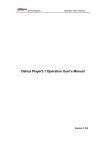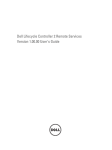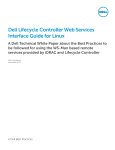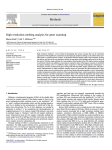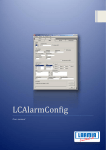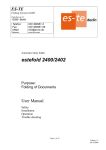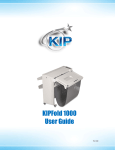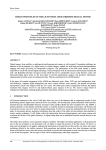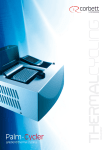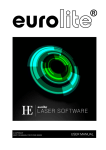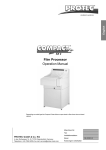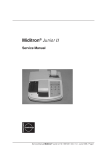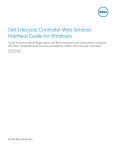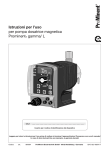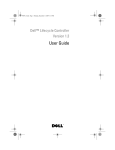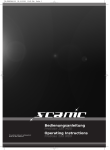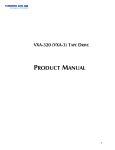Download Service Manual Light Cycler
Transcript
Service Manual Light Cycler Final 1.0 - January 1999 Light Cycler Service Manual Chapter 1 Application/Introduction Chapter 2 Installation Chapter 3 omitted Chapter 4 Mechanics Chapter 5 Electronics Note: In some wiring diagrams the fluorimeter is termed photometer ! Chapter 6 Software Chapter 7 Trouble Shooting Chapter 8 Spare Parts Chapter 9 omitted Chapter 10 Final 1.0 - January 1999 Maintenance Light Cycler 1 Service Manual Application/Introduction _________________________________ 2 1.1 LightCycler Workstation ______________________________________ 2 1.2 Technical Data ______________________________________________ 5 1.3 1.2.1 Instrument Specifications __________________________________________ 5 1.2.2 Application Specifications __________________________________________ 6 1.2.3 Detector Specifications ____________________________________________ 7 System Description __________________________________________ 8 1.3.1 1.4 The LightCycler ___________________________________________________ 8 Introduction _______________________________________________ 11 1.4.1 Instrument ______________________________________________________ 11 1.4.1.1 Principle of the LightCycler Technology ______________________________ 11 1.4.2 Instrument Components of the LightCycler ___________________________ 12 1.4.2.1 The Cycler Component _____________________________________________ 12 1.4.2.2 The Fluorimeter Component ________________________________________ 13 1.5 Warranty __________________________________________________ 14 Final 1.0 - January1999 Page 1 Chapter 1 Light Cycler Service Manual 1 Application/Introduction 1.1 LightCycler Workstation Contents of the Workstation The LightCycler components are listed in the following table: Component Description System component 1 · LightCycler™ Instrument · Sample Carousel (for Ø 1.5 mm capillary), premounted in LightCycler™ Instrument System component 2 · Capillaries, (96 capillaries and caps/box) · 32 Centrifuge adapters with 1 cooling block in an aluminium cooling block · LightCycler™ Operator´s Manual · Software Package · Cable (to connect LC to computer) · Power cord (German plug) · Power cord (U.S. plug) · Mouse Pad Recommended PC Hardware /8/98 · Vectra VE4 5/200 MMX Model 3200 Desktop · Intel Pentium MMX processor, 200 MHz · 64 MB SDRAM DIMM · 3.2 GB ultra-ATA/33 hard disk · On-board PCI vide: S3 Trio 64 V2, 2MB 50 ns DRAM · 24x speed DIE CD-ROM disk drive · Keyboard and PS/2 mouse Operating system Windows NT 4.0, including service pack III ZIP drive Internal Iomega ZIP drive, DIE interface (ATAPI) Monitor HP Ergo 1280, 17" monitor (HP# D2840A) Printer HP Deskjet 890C Color Inkjet Printer Tab.: cap1-1 Final 1.0 - January 1999 Page 2 Chapter 1 Light Cycler Service Manual Marks of Conformity The LightCyclerTM has been manufactured in accordance with EN 61010-1 (Safety Regulations for Measuring, Control and Laboratory Instruments; Part 1: General Requirements (IEC 1010-1 + A1: 1992, modified) and has been checked according to all relevant safety standards prior to leaving the factory. The instrument has been approved for use by recognized testing institutions. This is confirmed by the following test/conformity symbols: GS Certificated by VDE institute (Association of German Electrotechnical Engineers) CE The instrument conforms to current directives as issued by the European Union UL Certificated by Underwriters Laboratories Inc. CUL Certificated by Underwriters Laboratories for Canada – a testing facility recognized by the Standards Council of Canada (SSC) Tab.: cap1-2 All equipment to be connected must fulfill the standards set by IEC 950 (Safety of Information of Technology Equipment, Including Electrical Business Equipment). Final 1.0 - January1999 Page 3 Chapter 1 Light Cycler Service Manual Classification - ISM instrument, medium-sized, for industrial, laboratory and domestic use. The instrument is designed for stationary operation. Any false measurements produced are irrelevant from the safety point of view. The instrument is designated for worldwide marketing. It is intended for evaluating pre-processed biological material. The following should be noted: - The instrument may not be used in conjunction with infectious material without additional safety measures being taken. Final 1.0 - January 1999 Page 4 Chapter 1 Light Cycler 1.2 Technical Data 1.2.1 Instrument Specifications Service Manual General Data Dimensions Height 45 cm Width 30 cm Depth 45 cm Weight 20 kg Power supply 110-240 V ± 10%, 47-63 Hz Wattage 800 W Noise acc. to DIN 43635 < 80 dBA Heat emission, including PC, monitor and printer Max. 860 kcal/h Safety symbols CE, GS, UL, CSA or CUL Tab.: cap1-3 Environmental Parameters Temperature during operation 15 – 35°C Temperature required during operation to maintain specifications 15 – 30°C Temperature during transport/storage/packaging 20 – 60°C Relative humidity 20 – 80% Altitude / pressure 0 – 2000 m above sea level1030 – 850 hp Tab.: cap1-4 Samples No. of samples 32 Sample volume 2 – 20 µl Tab.: cap1-5 Final 1.0 - January1999 Page 5 Chapter 1 Light Cycler 1.2.2 Service Manual Application Specifications PCR Temperatures Temperature range 40 – 98°C Temperature accuracy of measuring system ± 0.3°C Heating rate Heating rate 40 – 95°C, step 40 – 95°C, time 10 – 90% 8s Heating rate 50 – 72°C, step 50 – 72°C, time 10 – 90% 4s Heating rate 72 – 98°C, step 72 – 95°C, time 10 – 90% 5s Cooling rate Cooling rate 95 – 40°C, step 95 – 40°C, time 10 – 90% 8s Cooling rate 95 – 60°C, step 95 – 60°C, time 10 – 90% 4s Temperature stability Temperature stability with respect to time, 95°C +1°C / -0.5°C range Temperature stability with respect to time, 65°C +1°C / -1.0°C range Temperature stability with respect to time, 40°C +1°C / -0.3°C range Temperature homogeneity Temperature homogeneity over all capillaries and time, 95°C ± 1.5°C range Temperature homogeneity over all capillaries and time, 65°C + 0.7°C / -1.5°C range Temperature homogeneity over all capillaries and time, 45°C + 1.5°C / -0.5°C range Tab.: cap1-6 Temperature Gradients Temperature gradient 0.1 °C/s, 0.2°C/s Temperature homogeneity for one capillary, 70 – 95°C ± 1.5°C range Temperature homogeneity for one capillary, 50 – 70°C ± 1.0°C range Temperature homogeneity for one capillary, all positions, 70 – 95°C ± 2.0°C range Temperature homogeneity for one capillary, all positions, 50 – 70°C ± 1.5°C range Temperature gradient 1.0 °C/s Temperature homogeneity for one capillary, 70 – 95°C ± 2.0°C range Temperature homogeneity for one capillary, 50 – 70°C ± 2.0°C range Temperature homogeneity for one capillary, all positions, 70 – 95°C ± 3.0°C range Temperature homogeneity for one capillary, all positions, 50 – 70°C ± 3.0°C range Temperature homogeneity for control of temperature peaks Stability at 95°C for dynamic cycles, 72 – 95 – 50°C, 0s maintained +2.0°C / -1.0°C range Homogeneity of capillary /capillary at 95°C for dynamic cycles, 72 – 95 – 50°C, 0s maintained +3.0°C / -1.0°C range Temperature homogeneity in capillary 20 µl, 70°C ± 1.0°C range 15 µl, 70°C ± 0.5°C range Tab.: cap1-7 Final 1.0 - January 1999 Page 6 Chapter 1 Light Cycler 1.2.3 Service Manual Detector Specifications Illumination Type LED Median wavelength 470 nm Output at 470 – 490 nm 0.1 mW Tab.: cap1-8 Detector Type Photohybrid Receptor surface 2.5* 2.5 mm² Sensitivity at 520 nm, 20 µl sample volume 15 nM fluorescein (1s) Sensitivity at 650 nm, 20 µl sample volume x nM fluorescein /LightCycler Red 640 Sensitivity at 700 nm, 20 µl sample volume x nM fluorescein / n.d. Electronic dynamic 12 bit Electronic bandwidth 1 kHz Integration time 20 ms Alteration of amplification range Factor 1 – 256 Tab.: cap1-9 Filter Detector 1 Bandpass 520 nm HBW 20 nm, dichroitic Detector 2 Bandpass 645 nm HBW 30 nm, dichroitic Detector 3 Bandpass 710 nm HBW 40 nm, dichroitic Tab.: cap1-10 Time Measuring time for 32 capillaries < 5s Tab.: cap1-11 Final 1.0 - January1999 Page 7 Chapter 1 Light Cycler 1.3 System Description 1.3.1 The LightCycler Service Manual Scheme of the Instrument Fig. scheme1 Final 1.0 - January 1999 Page 8 Chapter 1 Light Cycler Service Manual Description of the Instrument The sample capillaries are thermostatted with hot air in the thermal chamber; a ventilator ensures efficient aspiration, distribution and temperature homogeneity of the air during the heating process. During the cooling process, the ventilator operates at a higher speed in order to ensure adequate cooling. A heating coil controls the temperature. For measurement, the sample rotor is propelled by a stepper motor; this brings the capillary tip precisely to the focal point of the photometer optics. The photometer itself is placed in a radial position in relation to the signal maximum in order to compensate for any radial deviation of the capillary tip. 3 microprocessors incorporated in the instrument control the process. Processor 1 is for communication, processor 2 regulates the temperature and processor 3 controls the measurement procedure as well as the rotor and photometer movements. For online display, data are transmitted to the PC. Here, sample data are entered, the PCR reaction temperature is monitored, measurement modes and initial evaluation of melting point temperatures are carried out. Structure of the LightCycler The instrument comprises a basic lower and an upper unit. Basic Lower Unit Thermo-chamber, photometer, drive units, circuit boards and power supply are located in the basic unit. The base of the unit is a 10 mm cast aluminum plate onto which the various elements are fixed. This guarantees stability, especially for the thermo-chamber and photometer. Upper Unit The upper unit contains the heating coil, an excess temperature sensor and a cooler with sectional converter. Tab.: cap1-12 Final 1.0 - January1999 Page 9 Chapter 1 Light Cycler Service Manual Thermo-Chamber Thermostatting Thermostatting is done by using hot and cold air. A sensor with thermal time constants identical with those of the capillaries provides reference values for control purposes. The process is controlled by varying the heating coil voltage. During the heating phase, only the ventilator in the thermo-chamber is in operation; this guarantees a high degree of temperature homogeneity. During the cooling phase, both the capillaries and the heating coil must be cooled. The ventilator is then operated at a higher speed. 2 sensors are incorporated in order to prevent excess temperatures: Sensor I Sensor I is responsible for the temperature regulation. Sensor II Sensor II monitors the actual temperature. Tab.: cap1-13 Fluorescence Photometer A 3-channel fluorescence photometer is used for detection purposes. Sample excitation is initiated by a blue LED with an emission maximum of 470 nm. Fluorescence is detected by means of a separate photohybrid for each wavelength. Final 1.0 - January 1999 Page 10 Chapter 1 Light Cycler 1.4 Introduction 1.4.1 Instrument Service Manual 1.4.1.1 Principle of the LightCycler Technology System Description The LightCycler comprises two different instrument components: a cycler component and a fluorescence detection component. The combination of both components allows complex applications such as product analysis, quantification and mutation analysis. The cycler component has been optimized for rapid PCR applications. Compared with classical PCR where typical cycling programs take several hours, PCR analyses carried out in the LightCycler can be completed in only 15-30 min. This considerable time saving effect is due to very short temperature transfer times, the socalled „ramping“ times, of the LightCycler instrument. „Ramping“ times are the time periods necessary to reach the next pre-set temperature of a „cycling“ protocol in a PCR experiment. An example is the transition from 94°C to 55°C after sample denaturation for primer hybridization during the annealing phase. This sort of high-speed cycling is made possible by an optimized surface / volume ratio of the samples and the use of air as a temperature transfer medium. Fluorimetric Detection The combination of an optimized thermocycler and a fluorimeter not only enables “online” presentation of the PCR data obtained and efficient analysis of results, but also offers the user utmost flexibility. To meet individual requirements, different detection formats can be used by choosing and combining fluorescent dyes and detection probes. Fluorimetric detection of the PCR products formed consists of two different procedures: - sequence-specific detection by the double stranded DNA binding dye SYBRÒ Green I, or - sequence-specific oligonucleotides are coupled to suitable fluorophores as hybridization probes. Analysis of Results By means of the special LightCycler software, the data obtained from fluorimetric analysis can be evaluated and displayed. Additional cumbersome analytical procedures subsequent to PCR, e.g. restriction and gel analysis as well as blotting and hybridization experiments are no longer necessary. The direct and simple analysis of results also minimizes the contamination risk posed by samples and working materials due to a reduction of working steps required. Final 1.0 - January1999 Page 11 Chapter 1 Light Cycler 1.4.2 Service Manual Thermal Chamber Instrument Components of the LightCycler 1.4.2.1 The Cycler Component Sample Carousel The central element of the cylindrical thermal chamber is the sample rotor. The rotor takes 32 samples in glass capillaries with a diameter of 1.55 mm and a length of 35 mm. PCR analysis carried out in these specially manufactured glass capillaries reduces the reaction volume to only 5 to 20 ml max. The optimized surfaceto-volume ratio thus obtained allows for very short cycle times of only 15 to 20 seconds per cycle. The very favorable surface-to-volume ratio also guarantees an extremely rapid temperature change in the reaction mixture during each PCR cycle. At the same time, the glass capillaries serve as cuvettes for the fluorimetric determination of the PCR products formed. The cylindrical thermal chamber is supplied with hot air and air at ambient temperature by means of a fan with coupled heating coils. The incoming air is homogeneously distributed by a high-velocity fan at the base of the instrument, thus creating an even temperature throughout the reaction chamber. Surplus air is vented through an opening at the side of the chamber. The temperature is controlled by using an integrated measuring system with a temperature sensor installed in the direct vicinity of the sample capillaries of the sample carousel. The PCR thermal chamber is directly coupled to the optical system of the fluorimeter. Fig. scheme1 Final 1.0 - January 1999 Page 12 Chapter 1 Light Cycler Service Manual 1.4.2.2 The Fluorimeter Component Optics The fluorescent optical components of the LightCycler are schematically illustrated in chapter 1.3.1 The Light Cycler. A blue high-performance diode (blue LED) serves as energy source for sample excitation. The diode emits radiation which is spectrally filtered to a wavelength of 470 nm and an energy of 1 mW and is collimated (brought to the same wavelength) by means of a special optical system. The homogeneous light beam of 470 nm generated is subsequently focused onto the individual glass capillaries and then onto the samples to be measured in the sample carousel. The glass capillaries are moved by a high-precision stepper motor and placed in the optimal position for excitation and measurement. According to the spectral properties of the fluorophore used, the light emitted from the excited samples is guided into one of three channels (see drawing in chapter 1.3.1 The Light Cycler) via dichroitic mirrors for subsequent evaluation. In this channel, the emitted light beam is further collimated and spectrally concentrated by means of a special filter optical system. For final evaluation, the light beam is then focused onto a photomultiplier. The three evaluation channels of the LightCycler are fitted with filter combinations. Thus, analysis at the given emission wavelengths is possible and exact sample measurement can be carried out in parallel with the fluorophores given in Tab.: cap 1-14: Fluorophore Fluorescein SYBR Green I LC-Red 640* Excitation Channel Analysis Channel 1 2 3 470 nm±40 530 nm±20 640 nm±20 710 nm±40 490 nm 494 nm 525 nm 521 nm 640 nm Tab.: cap1-14 Table cap 1-14 Specification of excitation and measuring channels of the fluorimeter component of the Roche Diagnostics LightCycler: Comparison of the spectral properties of selected fluorophores. Abbreviations *: LC-Red = Light CyclerTM -Red 640 ** : LC-Red is not excited by the blue LED, but is a FRET partner of fluorescein. For further information, refer to the Operating Manual. Final 1.0 - January1999 Page 13 Chapter 1 Light Cycler 1.5 Service Manual Repairs Warranty As a general rule, all instrument repairs should be carried out by authorized and trained personnel only. Processing of Warranty Claims A warranty claim has to be processed by way of the Return Authorization procedure or any accepted equivalent. Please answer all the questions on the RA form with the greatest care. The warranty claim will only be accepted by the manufacturer if a detailed fault description is supplied. Complete instruments are accepted only in agreement with the Technical Product Management or with the responsible person of Roche Diagnostics Technical Support. Important Information: - Only parts marked with „A“ in the price list are generally accepted under warranty. - Return only parts marked with „R“ in the spare parts price list. - Warranty claim for “R” parts will be accepted, if the part has been returned to Mannheim. - All defective parts ( non-“R“ and „A“ parts ) should be kept for a period of 7 months, should the manufacturer need to investigate the part, in which case it will be requested. - All parts unduly returned to Mannheim will be sent back at the expense of each country's respective service center. - RA warranty claims are accepted no later than 8 weeks after the problem date. Parts which are worth repairing are marked with „R“ in the spare parts price list. New and repaired parts can be distinguished from each other by different material numbers (language version). (e.g. new part: 1234567-001, repaired part: 1234567984) Repaired parts should be ordered together with new parts via the order processing department in Mannheim (OU-VDG). Defective parts should be returned together with order of repair, including the filled out RA form (giving full details of the defect and marked choice box with repair), to Logistic Instruments (Incoming Goods) in Mannheim-Wohlgelegen (LI-LV). Repair of Instruments Complete instruments are accepted only, if the problem is definitety located in the photometer unit. The replacement should have been agreed with the Technical Product Management or with the responsible person of the Roche Diagnostics Technical Support. Terms of Delivery Shipments to countries with the routine truck are c.i.f./ other shipments are ex works Mannheim . Emergency shipments incur additional charges. Exclusion from Warranty The aforementioned warranties do not apply in case of improper use, handling, transportation or storage, faulty installation, repair or maintenance, chemical influence or contamination as well as damages resulting from that, failure to follow operating instructions, alterations or modifications of instruments or parts thereof not authorized or recommended by Roche Diagnostics and resulting damages, normal wear and tear and in case of other circumstances beyond the control of Roche Diagnostics. Final 1.0 - January 1999 Repair of Parts Marked with „R“ Charges "Repaired" parts (material no. 1234567-984) are supplied at a "repair price. There will be a subsequent charge consisting of the price difference between a new and repaired part, should the defective parts not be returned within 3 weeks (for European countries) and 8 weeks (for Overseas countries). Page 14 Chapter 1 Light Cycler Service Manual After receipt of a warranty claim for “A” parts, BMG will credit 100 % of the currently effective ex MA price. In case the manufacturer does not accept the warranty claim, each country's respective service center will be charged the R-price for "R" parts and the new price for non "R" parts. RA Form Return Authorization Please answer all the questions on the RA form with the greatest care and sign the form. - Country code Problem date Type of instrument Serial no. of the instrument Installation date of instrument Defective instrument or spare part Part number and material number of the spare part Old / new serial no. Fault description Alarm code Service / workshop report no. Instruments Not Under Warranty - Installation date of spare part All returned parts should be individually labeled with the corresponding RA no. and shipped together with the completed RA form to: Roche Diagnostics Logistic Instruments RA Management Friedrich Ebert Str. 100 D - 68167 Mannheim Germany Final 1.0 - January1999 Page 15 Chapter 1 Light Cycler Service Manual RA Form (Example) ROCHE DIAGNOSTICS GmbH Friedrich-Ebert-Strasse 100 D-68167 Mannheim Germany Telefon : Fax : +49 (621) 759 81 84 +49 (621) 759 80 93 Return Authorization No.: Country code: Date: Instrument: Serial No.: Installation date: Spare Part: Customer: Address: (will be filled in by BM) Part No.: Qty.: Part Name: Repair Comments Mat.-No.: Warranty Installation date of Spare Part: Warranty Repair OLD serial No.: Modification NEW serial No.: Replacement Fault Description: Alarm Code: Service Report No.: Place: Workshop Report No.: Date: Signature: Remarks (will be filled in by BM) NOS Credit FC BM Final 1.0 - January 1999 Page 16 Chapter 1 Light Cycler 2. Service Manual Installation _____________________________________________ 2 2.1 Installation Requirements ____________________________________ 2 2.2 Installation of the LightCycler _________________________________ 4 2.3 Computer and Software Installation ____________________________ 5 2.4 LightCycler De-installation ____________________________________ 6 2.5 Operation and Maintenance of the LightCycler ___________________ 7 Final 1.0 - January 1999 Page 1 Chapter 2 Light Cycler Service Manual 2. Installation 2.1 Installation Requirements Note - - The LightCycler should not be set up next to instruments that cause electromagnetic interference or have high inductance, e.g. centrifuges or mixers. All connected peripheral instruments must fulfill the requirements of Standard IEC 950 (UL 1950). All plugs used in the LightCycler workstation (PC, printer, monitor) should have the same phasing in order to prevent switch-on peaks and electronic noise generated by other instruments or the power supply itself. Use of an appropriate distributor plug with the LightCycler workstation is recommended. Working Place Requirements See the following table for the working place requirements: Dimensions and weight The LightCycler has a width of 30 cm, a depth of 45 cm and a height of 45 cm. It weighs approximately 20 kg. Voltage requirements The LightCycler operates on 120 – 240 V (50 – 60 Hz) and need not be adjusted. Power consumption The LightCycler requires approximately 800 W; PC and printer require a further 500 W. Tab.: cap2-1 The LightCycler must not be opened by the user The fuse may only be replaced if the instrument has been switched off at the mains. Environmental Requirements Please refer to the following table for the environmental requirements: Ambient temperature 15 – 35 °C (all specifications maintained between 15 and 30°C) Humidity 20 – 80 %, no condensation Altitude Sea level to 2000 m Excess voltage category II Degree of contamination 2 Tab.: cap2-2 Final 1.0 - January 1999 Page 2 Chapter 2 Light Cycler Service Manual Storage Conditions The LightCycler™ can be stored on5 the following conditions: Ambient temperature -20 - +60°C Humidity 20 – 80%, no condensation Tab.: cap2-3 Final 1.0 - January 1999 Page 3 Chapter 2 Light Cycler 2.2 Service Manual Installation of the LightCycler Installation of the Instrument Please refer to the following table for the installation of the LightCycler instrument: Step Action 1 Unpack the instrument. 2 Position instrument on bench, working surface. Allow 10 cm space left, right and behind. 3 Electrical connections: - Connect LightCycler to the PC using an R 232 cable (serial inter-face). - Connect LightCycler, PC, monitor and printer to same distributor plug. Tab.: cap2-4 Ensure that printer, monitor and PC have been set to the correct voltage. Final 1.0 - January 1999 Page 4 Chapter 2 Light Cycler 2.3 Service Manual Computer and Software Installation Installation of the PC After unpacking the computer, carry out the following steps: Step Action 1 Connect mouse, keyboard and monitor to the computer. 2 Connect the LightCycler to the computer with an R 232 cable (serial interface). 3 Connect computer, monitor and LightCycler to the distributor plug. The computer is now ready for operation Tab.: cap2-5 Software The complete software package is installed by Roche Diagnostics. Installation of Updates / Reinstallation In the following table you find information about the reinstallation and loading of updates: Step Action 1 Store any data, e.g. DATA, PROFILES and PROTOCOLs 2 Place LightCycler CD-ROM in appropriate disk drive (e.g. F) 3 Start set-up program (e.g. F:\SETUP.EXE). Tab.: cap2-6 Final 1.0 - January 1999 Page 5 Chapter 2 Light Cycler 2.4 Service Manual LightCycler De-installation De-installation of the Instrument Please refer to the following table for the de-installation of the instrument: Step Action 1 Switch off the instrument. 2 - Disconnect the RS 232 and power cables. - Clean according to the chapter on service and decontaminate if necessary. 3 Dispatch instrument in its original packaging. Tab.: cap2-7 Final 1.0 - January 1999 Page 6 Chapter 2 Light Cycler 2.5 Service Manual Operation and Maintenance of the LightCycler Guidelines for Operation - - - - The instrument may be operated only if protected from the weather. It may not be operated in buildings without temperature regulation facilities. If necessary, additional drying agents may be used to eliminate humidity. The instrument should not be operated near dripping, spraying, splashing or running water. The instrument is thus suitable for use according to classification 3K3 in accordance with Standard EN 60721-3-3. The instrument may be used at locations subject to noticeable or significant vibration; however, it should not be exposed to higher levels of shock waves. The instrument is thus suitable for use according to classification 3M4 in accordance with Standard EN 60721-3-3. The instrument is able to tolerate vibrations up to classification 3M6. However, based on expected locations of use, no significant and permanent vibrations or shock waves are to be expected. Transport and Storage When storing or transporting the instrument, it should not be exposed to extreme cold, e.g. as in the case of air freight. Temperatures lower than –25°C should be avoided (damage to optical systems). The optical systems are equipped with open ventilation systems and should therefore be protected from dirt and humidity. There are no further specifications for transport and storage. General Maintenance The instrument is maintenance-free. Cleaning the Instrument - Use 70% ethanol for disinfecting the incubator. Use only alcohol and an optical cloth for cleaning the optical window. Use a mild commercial detergent for domestic use for cleaning the housing. Final 1.0 - January 1999 Page 7 Chapter 2 Light Cycler 4 Service Manual Mechanics _____________________________________________ 3 4.1 Overview __________________________________________________ 3 4.2 Disassembly of the Housing Parts _____________________________ 4 4.2.1 Housing Lid ______________________________________________________ 4 4.2.2 Housing _________________________________________________________ 6 4.2.3 Panel ____________________________________________________________ 8 4.3 Sample Rotor and Fan Wheel _________________________________ 10 4.4 Heating Element ___________________________________________ 12 4.5 Chamber Lid_______________________________________________ 14 4.6 Rotor _____________________________________________________ 16 4.6.1 Stepper Motor Rotor ______________________________________________ 16 4.6.2 Fan Motor _______________________________________________________ 18 4.6.3 Measuring Chamber ______________________________________________ 20 4.7 Fluorimeter Drive ___________________________________________ 22 4.8 Lightbarriers and Sensors ___________________________________ 24 4.8.1 Location ________________________________________________________ 24 4.8.2 Rotor Lightbarrier ________________________________________________ 25 4.8.3 Interlock Lightbarrier _____________________________________________ 25 4.8.4 Fluorimeter Lightbarrier ___________________________________________ 26 4.8.5 Monitor Temperature Sensor _______________________________________ 26 4.8.6 Control Temperature Sensor _______________________________________ 27 4.8.7 Excess Temperature Switch ________________________________________ 27 Final 1.0 - January 1999 Page 1 Chapter 4 Light Cycler Service Manual 4.9 Power Supply ______________________________________________ 28 4.9.1 Location ________________________________________________________ 28 4.10 PCBs _____________________________________________________ 30 4.10.1 Location ________________________________________________________ 30 4.10.2 PCB Controller und Battery ________________________________________ 31 4.10.3 PCB Driver ______________________________________________________ 31 4.10.4 Status Board ____________________________________________________ 31 Final 1.0 - January 1999 Page 2 Chapter 4 Light Cycler 4 Mechanics 4.1 Overview Service Manual Fig. 160798k1 Final 1.0 - January 1999 Page 3 Chapter 4 Light Cycler 4.2 Disassembly of the Housing Parts 4.2.1 Housing Lid Service Manual 4.2.1.1 Location Fig. 140798k2 Final 1.0 - January 1999 Page 4 Chapter 4 Light Cycler Service Manual 4.2.1.2 Service Procedure Replaceable Components: - Housing lid (1) (is part of the housing set) Screw (2) (is part of the screw set) Gasket (61) Disassembly of the Housing Cover: - Flap housing lid (1) backwards Remove all screws (2) Remove housing lid (1) Disassembly of Gasket: - Flap housing lid (1) backwards Remove gasket (61). Final 1.0 - January 1999 Page 5 Chapter 4 Light Cycler 4.2.2 Service Manual Housing 4.2.2.1 Location Fig. 151298k1 Final 1.0 - January 1999 Page 6 Chapter 4 Light Cycler Service Manual 4.2.2.2 Service Procedure Replaceable Components: - Housing (3) (is part of the housing set) Screw (4) (is part of the srew set) Washer (5) (is part of the screw set) Disassembly of the Housing: - Remove all the screws (4) with washers (5) Lift off housing (3) Note: Please take care that the edges of the cover (3) do not scratch the front of the cover (3) Final 1.0 - January 1999 Page 7 Chapter 4 Light Cycler 4.2.3 Service Manual Panel 4.2.3.1 Location Fig. 140798k1 Final 1.0 - January 1999 Page 8 Chapter 4 Light Cycler Service Manual 4.2.3.2 Service Procedure Replaceable Components: - Screws (6) (are part of the screw set) Washers (7) (are part of the screw set) Panel (8) (is part of the housing set) Status board (9) Washers (10) (are part of the screw set) Nut (11) (is part of the screw set) Cable (12) (is part of the cable set) Disassembly of the Panel: - Remove housing, see chapter 4.2.2 Loosen all screws (13) Remove all the screws (6) with washers (7) Pull cable (12) Lift chamber lid (14) Take off panel (8) Disassembly of the Status Board: - Disassemble the panel (8) Remove nuts (11) with washers (10) Remove status board (9) 4.2.3.3 Wiring Cable (12) connects status board (9) to PCB controller JP12, see chapter 4.10.4 Final 1.0 - January 1999 Page 9 Chapter 4 Light Cycler 4.3 Sample Rotor and Fan Wheel 4.3.1 Location Service Manual Fig. 140798k7 Final 1.0 - January 1999 Page 10 Chapter 4 Light Cycler 4.3.2 Service Manual Service Procedure Replaceable Components: - Sample rotor (13) Fan wheel (15) Disassembly of the Sample Rotor: - Flap housing lid (1) backwards Remove sample rotor (13) Disassembly of Fan Wheel: - Disassemble the sample rotor (13) Remove nut (14) Remove fan wheel (15) by lifting it out Note: Do not tighten nut (14) too tight when mounting the fan wheel (15), or this might cause damage to the plastic fan motor thread. Final 1.0 - January 1999 Page 11 Chapter 4 Light Cycler 4.4 Heating Element 4.4.1 Location Service Manual Fig. 150798k1 Final 1.0 - January 1999 Page 12 Chapter 4 Light Cycler 4.4.2 Service Manual Service Procedure Replaceable Components: - Heating element (16) Cable (17) (is part of the cable set) Ground cable (29) (is part of the cable set) Disassembly of the Heating Element: - Flap housing lid (1) backwards, see chapter 4.2.1 Disassemble the housing (3), see chapter 4.2.2 Remove screw (23) with washer (24) Remove cable clip (25) with washer (26) Remove cable (17) from cable clip (25) Remove screws (18) Remove screw (19) Pull off cover sheet (20) Pull cable (17) Remove heating element (16) by lifting it out Remove sheathing (21) if necessary Disassembly of the Flange: - Disassemble the heating element (16) Remove screw (23) Remove flange (22) by lifting it out Disassembly of the Grounding: - Remove screw (27) with washer (28) Remove grounding (29) 4.4.3 Wiring Cable (17) connects heating element (16) to power supply, see chapter 4.9 Ground cable (29) connects base plate (30) to lower part of the housing (31) Final 1.0 - January 1999 Page 13 Chapter 4 Light Cycler 4.5 Chamber Lid 4.5.1 Location Service Manual Fig. 140798k3 Final 1.0 - January 1999 Page 14 Chapter 4 Light Cycler 4.5.2 Service Manual Service Procedure Replaceable Components: - Chamber lid (33) Damper (84) Screw (34) (is part of the screw set) Screw (35) (is part of the screw set) Washer (85) (is part of the screw set) Nut (65) (is part of the screw set) Disassembly of the Chamber Lid: - Disassembly of the housing parts, see chapter 4.2 Disassembly of the heating element, see chapter 4.4 Remove screws (34) Remove nut (86) and washer (85) Push damper (84) slightly to the side Lift out base plate (36) with chamber lid (33) and damper (84) Remove screws (35) and base plate (36) Unscrew damper (84) from base plate (36) Final 1.0 - January 1999 Page 15 Chapter 4 Light Cycler 4.6 Rotor 4.6.1 Stepper Motor Rotor Service Manual 4.6.1.1 Location Fig. 151298k2 Final 1.0 - January 1999 Page 16 Chapter 4 Light Cycler Service Manual 4.6.1.2 Service Procedure Replaceable Components: - Stepper motor rotor (43) Tooth belt (42) Cable (38) (is part of the cable set) Screw (39) (is part of the screw set) Washer (40) (is part of the screw set) Set screw (41) (is part of the screw set) Disassembly of the Tooth Belt: - Disassembly of the housing parts, see chapter 4.2 Disassembly of the heating element, see chapter 4.4 Disassembly of the chamber lid, see chapter 4.5 Pull cable (38) from PCB driver Remove screws (39) and washers (40) Turn set screw (41) in order to reduce tooth belt (42) tension Lift out tooth belt (42) Fig. 030898k1 Fix the fixation srews (39) of the stepper motor (43) and check again for proper movement. Disassembly of the Stepper Motor Rotor: - Disassembly of the tooth belt Lift out stepper motor rotor (43) 4.6.1.3 Wiring Cable (38) connects stepper motor rotor (43) to PCB driver, see chapter 4.10.3 4.6.1.4 Adiustments Belt tension of the sample rotor drive An adjustment of the belt tension is necessary if one of the following components is removed or replaced: - stepper motor (rotor) (43) - tooth belt (42) - measuring chamber (47) Proper adjustment of the belt tension ensures a minimum of friction between motor, belt and rotor. To adjust the belt tension, please proceed as follows: - Open the fixation screws (39) of the stepper motor (rotor) (43) about 1/4 of a turn, so that the motor can be moved in a horizontal direction - Adjust the tension with the adjustment screw (41) until the teeth of the belt fit properly into the grooves of the rotor drive, see drawing Final 1.0 - January 1999 Page 17 Chapter 4 Light Cycler 4.6.2 Service Manual Fan Motor 4.6.2.1 Location Fig. 151298k3 Final 1.0 - January 1999 Page 18 Chapter 4 Light Cycler Service Manual 4.6.2.2 Service Procedure Replaceable Components: - Fan motor (44) Screw (45) (is part of the screw set) Cable (46) (is part of the cable set) Cable (92) (is part of the cable set) Disassembly off the Fan Motor: - Disassembly of the housing parts, see chapter 4.2 Disassembly of the sample rotor and fan wheel, see chapter 4.3 Pull cable (46) Pull cable (92) Remove screws (45) Remove fan motor (44) by pulling it in a downward direction 4.6.2.3 Wiring Cable (46) and calbe (92) connects fan motor (44) to PCB driver, see chapter 4.10.3 4.6.2.4 Adjustmemt When assembling the heat dissipator of the fan motor (44), it is important that its edge is parallel to that of the fluorimeter. Please ensure that the dissipator does not touch the fluorimeter. Fig. 030898k1 Final 1.0 - January 1999 Page 19 Chapter 4 Light Cycler 4.6.3 Service Manual Measuring Chamber 4.6.3.1 Location Fig. 140798k8 Final 1.0 - January 1999 Page 20 Chapter 4 Light Cycler Service Manual 4.6.3.2 Service Procedure Disassembly of the Rotor Lightbarrier: Replaceable Components: - - Measuring chamber (47) Glass window for fluorimeter (56) Screw (52) (is part of the screw set) Washer (53) (is part of the screw set) Cable (48) (is part of the cable set) Cable (49) (is part of the cable set) Control temp. sensor (50) Monitor temp. sensor (51) Pull cable (60) Remove screws (57) and washers (58) Lift out rotor lightbarrier (59) 4.6.3.3 Wiring Disassembly of the Measuring Chamber and Glass Window for the Fluorimeter: Cable (48) connects control temp. sensor (50) to PCB controller, see 4.10.2. Cable (49) connects monitor temp. sensor (51) to PCB controller, see 4.10.2. Cable (60) connects rotor lightbarrier (59) to PCB controller, see 4.10.2. - 4.6.3.4 Adjustment - Disassembly of the housing parts, see chapter 4.2 Disassembly of the sample rotor and fan wheel, see chapter 4.3 Disassembly of the heating element, see chapter 4.4 Disassembly of the chamber lid, see chapter 4.5 Disassembly of the tooth belt, see chapter 4.6.1 Disassembly of the fan motor, see chapter 4.6.2 Pull cable (48) and cable (49) Unscrew control temp. sensor (50) Unscrew monitor temp. sensor (51) Remove screws (52) and washers (53) Lift out measuring chamber (47) Remove spring washer (54) Remove glass window (55) see chapter 4.8.6.1 Attention: Do not touch the window (55) with your fingers! A fingerprint would generate an additional flourecence signal, which would affect the measurement results! Carefully clean the window (55) with 70% ethanol, polishing it with a lint-free tissue afterwards. Assembly of the Window: - Please use the new spring washer (54) in case of a window (55) replacement - Ensure that the window (55) is placed in the correct position Fig. 040898k1 Final 1.0 - January 1999 Page 21 Chapter 4 Light Cycler 4.7 Service Manual Fluorimeter Drive The fluorimeter (65) is preadjusted by the manufacturer and is adjusted for the second time when it is assembled in the Light Cycler production plant in Germany. In case of a defective fluorimeter, the complete instrument is to be sent to Mannheim for repairing. Please use the RA procedure for the shipment to Mannheim, see chapter 1.5 The repaired instruments will be sent to you as soon as possible. Note: Please do not touch any of the fluorimeter (65) adjustment screws (especially focus screws). 4.7.1 Location Fig. 150798k2 Final 1.0 - January 1999 Page 22 Chapter 4 Light Cycler 4.7.2 Service Manual Service Procedures Replaceable Components: - Screw (62) (is part of the screw set) Screw (64) (is part of the screw set) Fluorimeter drive (64) Cable (66) (is part of the cable set) Disassembly: - Pull cable (66) Remove screws (62) and screws (63) Lift out fluorimeter drive (64) Note: If the fluorimeter drive is replaced, it is necessary to check the distance between stepper motor and the plate. When assembling the photometer drive, the distance between them should be 18mm +/- 1mm. If an adjustment is necessary, turn the plate until the required distance is reached. 4.7.3 Wiring Cable (66) connects fluorimeter drive (64) to PCB driver, see 4.10.3. Final 1.0 - January 1999 Page 23 Chapter 4 Light Cycler 4.8 Lightbarriers and Sensors 4.8.1 Location Service Manual Fig. 150798k3 Final 1.0 - January 1999 Page 24 Chapter 4 Light Cycler 4.8.2 Service Manual Rotor Lightbarrier 4.8.3 The rotor lightbarrier monitirs the rotations of the rotor. Interlock Lightbarrier The interlock lightbarrier is a reflection lightbarrier. It senses whether the housing lid is open or closed. Replaceable Components: Replaceable Components: - Rotor lightbarrier (59) Screw (57) (is part of the screw set) Washer (58) (is part of the screw set) Cable (60) (is part of the cable set) - Interlock lightbarrier (66) Screw (68) (is part of the screw set) Washer (67) (is part of the screw set) Cable (69) (is part of the cable set) Disassembly: Disassembly: - Disassembly of the housing parts, see chapter 4.2 Disassembly of the sample rotor and fan wheel, see chapter 4.3 Disassembly of the heating element, see chapter 4.4 Disassembly of the chamber lid, see chapter 4.5 Disassembly of the tooth belt, see chapter 4.6.1 Pull cable (60) Remove screw (57) and washer (58) Lift out rotor lightbarrier (59) - Disassembly of the housing, see chapter 4.2.2 Pull cable (69) Remove screw (68) and washer (67) Lift out interlock lightbarrier (66) 4.8.3.1 Wiring Cable (66) connects interlock lightbarrier (66) to PCB controller, see chapter 4.10.2 4.8.2.1 Wiring Cable (60) connects rotor lightbarrier (59) to PCB controller, see chapter 4.10.2 Final 1.0 - January 1999 Page 25 Chapter 4 Light Cycler 4.8.4 Service Manual Fluorimeter Lightbarrier 4.8.5 Monitor Temperature Sensor The fluorimeter lightbarrier monitirs the fluorimeter movements. The monitor temperature sensor monitors the measuring chamber temperature and prevents excess temperature. Replaceable Components: Replaceable Components: - - Fluorimeter lightbarrier (70) Screw (72) (is part of the cable set) Washer (71) (is part of the screw set) Cable (73) (is part of the cable set) Disassembly: Disassembly: - - - - Monitor temperature sensor (51) Cable (49) (is part of the cable set) Disassembly of the housing, see chapter 4.2.2 Pull cable (73) Remove screw (72) and washer (71) Lift out fluorimeter lightbarrier (70) Disassembly of the panel, see chapter 4.2.3 Pull cable (49) Unscrew monitor temperature sensor (51) 4.8.5.1 Adjustment see chapter 4.8.6.1 4.8.4.1 Wiring Cable (73) connects fluorimeter lightbarrier (70) to PCB controller, see chapter 4.10.2 4.8.5.2 Wiring Cable (49) connects monitor temperature sensor (51) to PCB controller, see chapter 4.10.2. Final 1.0 - January 1999 Page 26 Chapter 4 Light Cycler 4.8.6 Service Manual Control Temperature Sensor 4.8.7 The control temperature sensor controls excess temperature in the measuring chamber. Excess Temperature Switch The excess temperature switch is a bimetal switch which protects the Light Cycler from overheating, e.g due to excess periods of operation. Replaceable Components: Replaceable Components: - Control temperature sensor (50) Cable (48) (is part of the cable set) - Disassembly: - Disassembly of the panel, see chapter 4.2.3 Pull cable (48) Unscrew control temperature sensor (50) Excess temperature switch (74) Screw (76) (is part of the screw set) Washer (75) (is part of the screw set) Cable (77) (is part of the cable set) Disassembly: - 4.8.6.1 Adjustment Disassembly of the housing, see chapter 4.2.2 Pull cable (77) Remove screw (76) and washer (75) Lift out excess temperature switch (74) Temperature Sensors Two temperature sensors for temperature control and temperature monitoring are located in the measuring chamber of the light cycler. The sensors should be placed close to the capillaries in the sample rotor so that the temperature can be monitored as accurately as possible. However, the sensors must not touch the capillaries when the rotor is moving. For this reason, the height of these sensors needs to be adjusted. 4.8.7.1 Wiring Cable (77) connects excess temperature switch (74) to PCB controller, see chapter 4.10.2 See drawing below: Fig. 030898k1 The height can be adjusted by turning the sensor fixation screws clockwise or counterclockwise. 4.8.6.2 Wiring Cable (48) connects control temperature sensor (50) to PCB controller, see chapter 4.10.2. Final 1.0 - January 1999 Page 27 Chapter 4 Light Cycler 4.9 Power Supply 4.9.1 Location Service Manual Fig. 230998k1 Final 1.0 - January 1999 Page 28 Chapter 4 Light Cycler 4.9.2 Service Manual Service Procedure Replaceable Components: - Power supply (81) Cable (17) (is part of the cable set) Cable (90) (is part of the cable set) Cable (91) (is part of the cable set) Screw (88) (is part of the screw set) Screw (89) (is part of the screw set) Disassembly of the Power Supply: - Disassembly of the housing parts, see chapter 4.2 Pull cable (17) Pull cable (90) Pull cable (91) Remove screws (88) Remove screw (89) Pull out the power supply (81) 4.9.3 Wiring Cable (17) connects power supply (81) to heating element, see chapter 4.4. Cable (90) connects power supply (81) to PCB controller, see chapter 4.10.2. Cable (91) connects power supply (81) to PCB driver, see chapter 4.10.23 Final 1.0 - January 1999 Page 29 Chapter 4 Light Cycler Service Manual 4.10 PCBs 4.10.1 Location Fig. 100898k1 Final 1.0 - January 1999 Page 30 Chapter 4 Light Cycler Service Manual 4.10.2 PCB Controller und Battery 4.10.4 Status Board The PCB controller of the Light Cycler houses the essential control functions, data recording and communication with the PC via interface RS232. was macht dieses? Replaceable Components: - - - PCB controller (78) Battery (79) Disassembly: Disassembly of the panel (8) see chapter 4.2.3 Remove nuts (11) with washers (10) Remove status board (9) Pull cable (12) Disassembly of the PCB Controller: - Disassembly of the housing, see chapter 4.2.2 Pull all the connecting cables from the PCB controller (78) Remove the PCB controller (78) located on the side 4.10.4.1 Wiring Cable (12) connects status board (9) to PCB controller JP12, see chapter 4.10.2 Disassembly of the Battery: - Disassembly of the housing, see chapter 4.2.2 Remove battery (79) from the PCB controller (78) 4.10.2.1 Wiring Aufzählung der Kabel, die zum PCB Controller gehen! 4.10.3 PCB Driver was macht dieses? Replaceable Components: - PCB Driver (80) Screws (82) (are part of the screw set) Washers (83) (are part of the screw set) Disassembly: - Disassembly of the housing, see chapter 4.2.2 Pull all the connecting cables from the PCB driver (80) Remove screws (82) and washers (82) Lift out PCB driver (80) 4.10.3.1Wiring Aufzählung der Kabel, die zum PCB Controller gehen! Final 1.0 - January 1999 Page 31 Chapter 4 Light Cycler 5 Service Manual Electronics ____________________________________________ 3 5.1 Overview __________________________________________________ 3 5.2 Cable Connections __________________________________________ 4 5.3 PCB Controller ______________________________________________ 5 5.4 5.5 5.6 5.3.1 Location _________________________________________________________ 5 5.3.2 Block Diagram PCB Controller ______________________________________ 6 5.3.3 Printed Circuit Diagram PCB Controller _______________________________ 7 5.3.4 Layout Diagram PCB Controller ____________________________________ 11 PCB Driver ________________________________________________ 13 5.4.1 Location ________________________________________________________ 13 5.4.2 Block Diagram PCB Driver _________________________________________ 14 5.4.3 Printed Circuit Diagram PCB Driver _________________________________ 15 5.4.4 Layout Diagram PCB Driver ________________________________________ 18 Status Board ______________________________________________ 20 5.5.1 Location ________________________________________________________ 20 5.5.2 Printed Circuit Diagram Status Board ________________________________ 21 5.5.3 Layout Diagram Status Board ______________________________________ 22 Lightbarriers and Sensors ___________________________________ 23 5.6.1 5.7 Location ________________________________________________________ 23 Power Supply ______________________________________________ 24 5.7.1 Location ________________________________________________________ 24 Final 1.0 - January 1999 Page 1 Chapter 5 Light Cycler Service Manual 5.8 Heating Element ___________________________________________ 25 5.8.1 5.9 Location ________________________________________________________ 25 Fluorimeter ________________________________________________ 26 5.9.1 Location ________________________________________________________ 26 5.9.2 Block Diagram Fluorimeter ________________________________________ 27 5.9.3 Printed Circuit Diagram PCB Fluorimeter_____________________________ 28 5.4.4 Layout Diagram PCB Fluorimeter ___________________________________ 29 Final 1.0 - January 1999 Page 2 Chapter 5 Light Cycler 5 Electronics 5.1 Overview Service Manual Fig. 5-2 Final 1.0 - January 1999 Page 3 Chapter 5 Light Cycler 5.2 Service Manual Cable Connections Fig. cap5-2 Final 1.0 - January 1999 Page 4 Chapter 5 Light Cycler 5.3 PCB Controller 5.3.1 Location Functional Description of the PCB Controller of the LightCycler The PCB controller of the Light Cycler houses the essential control functions, data recording and communication with the PC via RS232. Service Manual - EEPROM for storing the device-specific calibration data and various parameters as well as the serial numbers of the instrument and the fluorimeter - Digital-to-analog converter and driver for regulating the LED current for the blue fluorimeter LED - 12 bit analog-to-digital converter for converting the voltage analog to the temperature for temperture regulation by means of the temp. processor - Multi-channel 12 bit analog-to-digital converter for converting the measuring values of the 3 fluorimeter channels and the temperature for the display - Data interface with the power supply for transferring the actual set values for the heating voltage (this serial interface is also galvanically isolated from the power supply via optocoupler) These functions are: - Interface RS232, galvanically isolated via optocoupler, serves for communication with the PC. - Interface management between PC and temp. and/or step processor by means of a PIC processor - 2 microprocessors (temp. processor and step processor) for temperature regulation, positioning of the stepper motors and recording of the measuring values - 2 temperature measuring channels: - Channel 1 for regulating the chamber temperature by means of the temp. processor, indication of the actual temperature in the measuring chamber and control of excess temperature. Channel 2 for control of excess temperature PCB Controller Fig. 221298k1 Final 1.0 - January 1999 Page 5 Chapter 5 Light Cycler 5.3.2 Service Manual Block Diagram PCB Controller Fig. cap5-3-2 Final 1.0 - January 1999 Page 6 Chapter 5 Light Cycler 5.3.3 Service Manual Printed Circuit Diagram PCB Controller Page 1 of 4 Fig. main-a Final 1.0 - January 1999 Page 7 Chapter 5 Light Cycler 5.3.3 Service Manual Printed Circuit Diagram PCB Controller Page 2 of 4 Fig. main-c Final 1.0 - January 1999 Page 8 Chapter 5 Light Cycler 5.3.3 Service Manual Printed Circuit Diagram PCB Controller Page 3 of 4 Fig. main-b Final 1.0 - January 1999 Page 9 Chapter 5 Light Cycler 5.3.3 Service Manual Printed Circuit Diagram PCB Controller Page 4 of 4 Fig. main-d Final 1.0 - January 1999 Page 10 Chapter 5 Light Cycler 5.3.4 Service Manual Layout Diagram PCB Controller Page 1 of 2 Fig. main-e Final 1.0 - January 1999 Page 11 Chapter 5 Light Cycler 5.3.4 Service Manual Layout Diagram PCB Controller Page 2 of 2 Fig. main-f Final 1.0 - January 1999 Page 12 Chapter 5 Light Cycler 5.4 PCB Driver 5.4.1 Location Service Manual Functional Description of the LightCycler Power Board The LightCycler power board houses the following functions: - Driver for the stepper motor of the rotor - Driver for the linear stepper motor of the fluorimeter drive - Linear controller for driving the chamber fan, setting the actual setpoint value by means of a serial 12 bit digital-to-analog converter - The speed of the chamber fan which is equipped with an encoder is controlled by means of a frequency converter and one comparator each for minimum and maximum speed (releasing or blocking of the heating voltage depends on this) PCB Driver Fig. 221298k2 Final 1.0 - January 1999 Page 13 Chapter 5 Light Cycler 5.4.2 Service Manual Block Diagram PCB Driver Fig. cap5-4-2 Final 1.0 - January 1999 Page 14 Chapter 5 Light Cycler 5.4.3 Service Manual Printed Circuit Diagram PCB Driver Page 1 of 3 Fig. power-a Final 1.0 - January 1999 Page 15 Chapter 5 Light Cycler 5.4.3 Service Manual Printed Circuit Diagram PCB Driver Page 2 of 3 Fig. power-b Final 1.0 - January 1999 Page 16 Chapter 5 Light Cycler 5.4.3 Service Manual Printed Circuit Diagram PCB Driver Page 3 of 3 Fig. power-c Final 1.0 - January 1999 Page 17 Chapter 5 Light Cycler 5.4.4 Service Manual Layout Diagram PCB Driver Page 1 of 2 Fig. power-d Final 1.0 - January 1999 Page 18 Chapter 5 Light Cycler 5.4.4 Service Manual Layout Diagram PCB Driver Page 2 of 2 Fig. power-e Final 1.0 - January 1999 Page 19 Chapter 5 Light Cycler 5.5 Status Board 5.5.1 Location Service Manual Statusboard Fig. 221298k3 Final 1.0 - January 1999 Page 20 Chapter 5 Light Cycler 5.5.2 Service Manual Printed Circuit Diagram Status Board Fig. c5-5-3 Final 1.0 - January 1999 Page 21 Chapter 5 Light Cycler 5.5.3 Service Manual Layout Diagram Status Board grün rot gelb Fig. c5-5-4 Final 1.0 - January 1999 Page 22 Chapter 5 Light Cycler Service Manual 5.6 Lightbarriers and Sensors 5.6.1 Location Control Temperature Sensor The control temperature sensor controls excess temperature in the measuring chamber. Rotor Lightbarrier The rotor lightbarrier controls the rotations of the rotor. L Interlock Lightbarrier The interlock lightbarrier is a reflection lightbarrier. It senses whether the housing lid is open or closed. Excess Temperature Switch The excess temperature switch is a bimetal switch which protects the Light Cycler from overheating, e.g due to excess operating periods. Fluorimeter Lightbarrier The fluorimeter lightbarrier controls the fluorimeter movements. Monitor Temperature Sensor The monitor temperature sensor controls the measuring chamber temperature and prevents excess temperature. Interlock lightbarrier Excess temperature switch Lightbarrier home position Rotor Control temperature sensor Lightbarrier home position Fluorimeter S2 S1 Monitor temperature sensor Fig. cap5-6 Final 1.0 - January 1999 Page 23 Chapter 5 Light Cycler 5.7 Power Supply 5.7.1 Location Service Manual Functional Description of the LightCycler Power Supply The power supply is a functional unit and is accommodated in a metal housing closed on all sides. It is connected to the mains by means of an integrated rubber connector. Fuses are "off limits" to the customer because all outputs are short-circuit proof. A blown fuse is an indication of a defect that cannot and should not be fixed by the customer. The power supply has three output plugs: - a 12-pin plug with the following outputs: - 5 V for the supplying of digital functions on the PCB controller. - +/- 12V for the supplying of analog switching functions on the PCB controller; furthermore for serial data transfer for the supplying of the heating element integrated in the power supply. - a 10-pin plug with the following outputs: - 5V for the supplying of digital functions on the power board. - 24V as driver voltage for the stepper motor drivers and the chamber fan driver. - a 2-pin plug for connecting the heating element; voltage range of this output: 0 - 90V DC. Power supply Fig. 221298k4 Final 1.0 - January 1999 Page 24 Chapter 5 Light Cycler Service Manual 5.8 Heating Element 5.8.1 Location Heating element Fig. 240998k2 Final 1.0 - January 1999 Page 25 Chapter 5 Light Cycler 5.9 Fluorimeter 5.9.1 Location Service Manual Functional Description of the Fluorimeter The fluorimeter is located on a linear bearing below the measuring chamber. It can be moved radially with the help of a linear stepper motor. It has an excitation channel and 3 measuring channels with different wavelengths. The essential features of the fluorimeter are its metallic body with a system of optical lenses and filters and 4 printed circuit boards with the following functions: - a LED PCB with a blue light emitting diode for illuminating the capillaries. - three identical printed circuit boards with optohybrids (photodiode with integrated amplifier) and programmable amplifiers. A 12 bit analog-to-digital converter is used for programming the amplifiers as well as for the offset adjustment, with which a negative output value of the optohybrids can be corrected. Both 12 bit analog-to-digital converters are accommodated in a housing and are serially activated via a 24 bit string. For activating and transferring the measuring values, the fluorimeter PCBs are connected to the PCB controller with a cable (plug JP1 on PCB controller). Fluorimeter Fig. 221298k2 Final 1.0 - January 1999 Page 26 Chapter 5 Light Cycler 5.9.2 Service Manual Block Diagram Fluorimeter Fig. cap5-9-2 Final 1.0 - January 1999 Page 27 Chapter 5 Light Cycler 5.9.3 Service Manual Printed Circuit Diagram PCB Fluorimeter Fig. flour-a Final 1.0 - January 1999 Page 28 Chapter 5 Light Cycler 5.4.4 Service Manual Layout Diagram PCB Fluorimeter Page 1 of 2 Fig. flour-b Final 1.0 - January 1999 Page 29 Chapter 5 Light Cycler 5.4.4 Service Manual Layout Diagram PCB Fluorimeter Page 2 of 2 Fig. fluor-c Final 1.0 - January 1999 Page 30 Chapter 5 Light Cycler 6 Service Manual Service Software ________________________________________ 2 6.1 Hardware requirements ______________________________________ 2 6.2 Installation of Windows NT ____________________________________ 2 6.3 BIOS Settings_______________________________________________ 2 6.4 Basic setup actions __________________________________________ 2 6.4.1 Logon as administrator ____________________________________________ 2 6.4.2 Create directory and set run mode of a program _______________________ 2 6.4.3 Check desktop properties __________________________________________ 2 6.4.4 Change the reginonal settings ______________________________________ 2 6.4.5 Set system parameters _____________________________________________ 2 6.4.6 Set administrator password/create LC_Service and LC_User account _____ 3 6.4.6.1 Change Administrator password _____________________________________ 3 6.4.6.2 Create LC_Service account _________________________________________ 3 6.4.6.3 Create LC_User account ___________________________________________ 3 6.5 6.6 6.7 Setup LC_User account ______________________________________ 3 6.5.1 Desktop properties ________________________________________________ 3 6.5.2 Regional settings _________________________________________________ 3 Setup LC_Service account ____________________________________ 3 6.6.1 Desktop properties ________________________________________________ 3 6.6.2 Reginonal settings ________________________________________________ 4 Install LightCycler service and customer software ________________ 4 Final 1.0 - January 1999 Page 1 Chapter 6 Light Cycler Service Manual 6 Service Software 6.4 Basic setup actions 6.1 Hardware requirements 6.4.1 Logon as administrator This chapter descripes the minimal system to control the LightCycler: Vectra VE4 5/200 MMX Modell 3200 Desktop HP# D5606N - Intel Pentium MMX Processor, 200 MHz 64 MB SDRAM DIMM 3,2 GB Ultra-ATA/33 Hard disk On-board PCI-Video: S3 Trio 64 V2, 2MB 50ns DRAM - 24-times Speed IDE CD-ROM drive - Keyboard and PS/2 Mouse - Operatingd system: Windows NT 4.0 inclusive service pack 3 and hotfixes, english version Logon User name: Password: Administrator ***** Only “Password never expires” should be marked! 6.4.2 Create directory and set run mode of a program Start the explorer and ... - create folder: C:\Users - select file: C:\Winnt\Profiles\AllUsers\Start Menu\Programs\ Startup\Iomega Quick Tools NT Internal Iomega ZIP-drive, IDE-interface (ATAPI) HP Ergo 1280, 17” Monitor (HP# D2840A) with right mouse button -> Properties -> Shortcut ->Run: Mininized -> OK Optional component not generally supplied with the instrument: 6.4.3 HP DeskJet 890C, Color InkJet printer 6.2 Installation of Windows NT During installation of Windows NT the following parameters should be set: - Display mode settings: 1024*768 pixels, 256 colors, small fonts - Hard disk format: one NTFS partition Check desktop properties Display properties: Background -> Pattern -> Weave ScreenSaver -> Logon Screen Saver Password protected Wait: 10 min Settings -> Color palette: 256 colors Desktop area: 1024 by 768 pixels Font size: Small fonts Refresh frequency: 75 Hertz 6.4.4 Change the reginonal settings Start -> Settings -> Control Panel -> Regional Settings 6.3 BIOS Settings This parameters are recommended. The changed boot priority is the best protection against boot viruses. Advanced -> Boot-time diagnostic screen: disabled Boot -> Boot device priority -> 1. Hard disk 2. Removable devices 3. ATAPI CD-ROM device Reginal settings properties: - Regional settings: english (United States) Number -> Measurement System: Metric Time -> Time style: HH:mm:ss Date -> Short date style: dd-MMM-yy -> Long date style: dddd, dd MMMM, yyyy -> OK 6.4.5 Set system parameters Start -> Settings -> Control Panel -> System - Startup/Shutdown -> System startup -> Show list for 3 seconds - Recovery -> Write an event to the system log -> Automatically reboot Final 1.0 - January 1999 Page 2 Chapter 6 Light Cycler 6.4.6 Service Manual Set administrator password/create LC_Service and LC_User account 6.5 Setup LC_User account Logon as LC_User: Start -> Programs -> Administrative Tools (Common) -> User Manager CTRL + ALT + DEL -> Logon window: Logon User name: Password: 6.5.1 Desktop properties 6.4.6.1 Change Administrator password LC_User ***** Double click “Administrator” -> Password: ****** Confirm Password: ****** -> OK Display properties: Background -> None / None ScreenSaver -> Starfield Simulation No Password protection Wait: 15 min 6.4.6.2 Create LC_Service account Select “ Administrator” -> User -> Copy 6.5.2 Username: Full name: Description: Password: Confirm password: Start -> Settings -> Control Panel -> Regional Settings LC_Service LightCycler Service ****** ****** Only “Password never expires” should be marked ! -> Groups -> Member of: Administrators -> OK -> Profile -> Home directory -> Local Path: C:\LC_Service Regional settings Reginal settings properties: - Regional settings: english (United States) Number -> Measurement System: Metric Time -> Time style: HH:mm:ss Date -> Short date style: dd-MMM-yy -> Long date style: dddd, dd MMMM, yyyy -> OK -> OK -> OK 6.6 Setup LC_Service account 6.4.6.3 Create LC_User account Logon as LC_Service: -> User -> New User CTRL + ALT + DEL -> Logon window: Username: Full name: Description: Password: Confirm password: LC_User LightCycler User ***** ***** Only “Password never expires” should be marked ! -> Groups -> Member of: Poweruser -> OK -> Profile -> Home directory -> Local Path: C:\Users\LC_User -> OK -> OK -> Exit Start -> Shutdown -> Close all programs and logon as different user -> YES Final 1.0 - January 1999 Logon User name: Password: LC_Service ***** 6.6.1 Desktop properties Display properties: Background -> Pattern -> None Wallpaper -> LcService -> Display: Tile ScreenSaver -> Logon Screen Saver Password protected Wait: 15 min Settings -> Color palette: 256 colors Desktop area: 1024 by 768 pixels Font size: Small fonts Refresh frequency: 75 Hertz Page 3 Chapter 6 Light Cycler 6.6.2 Service Manual Reginonal settings Start -> Settings -> Control Panel -> Regional Settings Reginal settings properties: - Regional settings: english (United States) Number -> Measurement System: Metric Time -> Time style: HH:mm:ss Date -> Short date style: dd-MMM-yy -> Long date style: dddd, dd MMMM, yyyy -> OK 6.7 Install LightCycler service and customer software Logon as LC_Service: CTRL + ALT + DEL -> Logon window: Logon User name: Password: LC_Service ***** After logon process is ready insert LightCycler service CD-ROM. The setup routine of ServiceTools starts after some seconds automaticallly. -> Next -> Next -> Finish Please copy the links of the little LC_Service window to the desktop (TestAdj and LcEdit). The setup of the customer software must be started with the command Drive:\LightCycler\Setup.exe Final 1.0 - January 1999 Page 4 Chapter 6 Light Cycler 7 Service Manual Troubleshooting Error Description Possible Reason`s What To Do - Chanber fan or rotor stepper are not running - Interlock sensor not adjusted - reflex area at the lid is not shiny - Sensor defect - check output from sensor: voltage on pin3 from JP6 must be 0.2V(+0.2), if the lid is closed (if open, then +5V) - control the reflex are and clean it if necessery - change and adjust the light barrier - no heating function - seeabove about interlock sensor - see above - the heating coil is broken - change the heating coil - the power supply for heating is out of order - check pin8 from IC14 (must be - the overheat latch is seted +5V if the cover is closed), if not then check pin7 from IC23 and IC24 (both must be low, if not, a overheat is detected) - no flourimeter signal on all channel`s - the blue LED dosent work - check the blue LED from Photometer - check the interlock sensor cap7.tbl Final 1.0 - January 1999 Page 1 Chapter 7 Light Cycler 8 Service Manual Spare Parts ____________________________________________ 2 8.1 Part Identification ___________________________________________ 2 8.2 Complete Spare Part List _____________________________________ 3 8.3 Tools ______________________________________________________ 4 Final 1.0 - January 1999 Page 1 Chapter 8 Light Cycler 8 Spare Parts 8.1 Part Identification Service Manual Fig. Cap8-1 Final 1.0 - January 1999 Page 2 Chapter 8 Light Cycler 8.2 Service Manual Complete Spare Part List ID Spare Part Partname BTO R A ABC Reference No. 1909282001 Samplerotor 13 2024039001 Fan Wheel 15 2024004001 Heating Element 16 2023962001 Gasket for Chamber Lid 61 Chamber Lid X 33 2024012001 Stepmotor (Rotor) 43 2023989001 Tooth Belt 42 PCB Driver 80 PCB Controler 78 Power Supply 81 Fluorimeter Drive 64 Fan Motor 44 Temperature Sensor (Control) 50 Temperature Sensor (Monitor) 51 2023954001 Measuring Chamber 47 2023997001 Window Fluorimeter 56 PCB Status LED 9 Lightbarrier Rotor 59 Lightbarrier Interlock 66 Excess Temperature Switch 74 Lightbarrier Fluorimeter 70 Battery 79 Damper 84 2023946001 Housing Set cpl. Screwset Cable Set Fig. cap8-2 Final 1.0 - January 1999 Page 3 Chapter 8 Light Cycler 8.3 Service Manual Tools Allan key 2.0 2.5 3.0 4.0 mm mm mm mm Wrench 4.5 7 8 14 mm mm mm mm Socket spanner 4.5 mm 5.5 mm Phillips screwdriver size 1, length 100 mm size 0, length 100 mm Snap ring pliers 10 - 25 mm for window photometer Final 1.0 - January 1999 Page 4 Chapter 8 Light Cycler 10 Service Manual Maintenance The Light Cycler is a maintenance-free instrument. Keep the instrument surface and the outer parts of the instrument clean for hygienic reasons. Use a commercial detergent or disinfectant, preferably 70% isopropanol, if necessary. Final 1.0 - January 1999 Page 1 Chapter 10


































































































